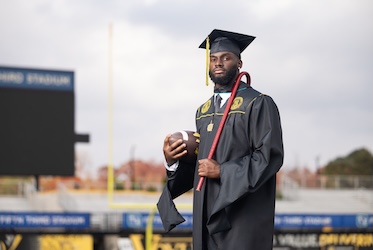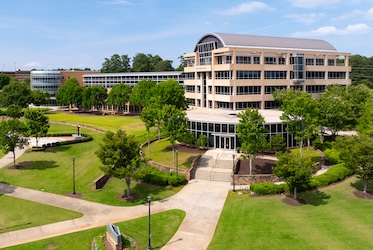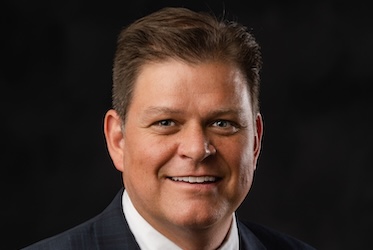

KENNESAW, Ga. | Aug 5, 2019
Avatar lab provides a world of scenarios
Teachers encounter all sorts of situations when they’re instructing students in the classroom, and the Bagwell College of Education is taking an animated approach to preparing teacher candidates for scenarios they
will experience as educators.
The BCOE has a new laboratory where Kennesaw State students and faculty utilize mixed-reality
technology to interact with avatars of children and adults, simulating a variety of
situations and challenges teachers can encounter. The student avatars each have their
own unique personalities, and the scenarios have low, medium and high settings requiring
varying levels of problem-solving.
“The lab’s capabilities are endless for providing purposeful practice for teacher candidates before they ever step foot in a classroom,” said Kate Zimmer, interim chair of the Department of Inclusive Education and an associate professor of special education.
After securing grant funding to establish the avatar lab at KSU, Zimmer and one of
her colleagues, special education assistant professor Melissa Driver, began integrating
it into classes for undergraduate and graduate students earlier this year. Kennesaw
State is one of about 30 universities in the country with a site license to utilize
the technology offered by the company Mursion, which can be renewed annually.

The lab enables education majors to receive real-time feedback from their peers and
instructors as they engage with the avatars, which can be programmed to be students
ranging from second grade to high school. The student avatars have abilities and personalities
such as an advanced student, an introvert, a rule-follower and the class clown, and
will act accordingly, depending on how the teacher is conducting class.
“The mixed-reality aspect is the key, because having ‘students’ respond to you in live time increases the authenticity,” Driver said.“If you are effectively engaging the students, they’re going to participate and show interest in the lesson. But if you are unclear with your instruction or become unsure of yourself – maybe you’re rustling through your papers or taking too long to transition – the students will disengage and express their disinterest by becoming more talkative, acting out or just shutting down.”
Along with the child avatars of different ages and personalities, the program provides
scenarios that teachers will encounter with adults. That could include practicing
having a difficult conversation with a parent or preparing for a teacher-principal
conference.
“In special education, for example, you work with such a variety of people,” Zimmer said. “It’s not just the interactions with parents, but also the many other service professions that you work with – a co-teacher, a principal, a paraprofessional – and it’s hard to be able to get that practice within a field experience.”
If a teacher candidate doesn’t know how to handle a particular situation or what to say next, the avatar lab offers a function that teachers don’t have the benefit of in a real classroom – a pause button. At any point, the teacher can pause the simulation and ask for help from their professor or peers.
“You can’t do that in real life when you’re teaching a group of seventh-graders,” Driver said. “Also, once you receive feedback, you can re-teach the same lesson – which you couldn’t do in a real classroom because your students already would’ve sat through that lesson once.”
That practical training is how the avatar lab is “changing the game” in how teachers are prepared for their careers, according to Driver. They can use the cutting-edge technology to practice teaching, work on classroom management and improve their communication skills so they can be ready for their first real classroom.
“The practice element for teacher candidates in the past often has been an either/or – either they’re learning through their coursework or they’re practicing on students out in the field,” Driver said. “This is truly a middle step to actually practice something they’ve learned before getting to the real-life students.”
Data has been collected and analyzed to show Kennesaw State stakeholders that the
avatar lab is helping teacher candidates develop the skills that educators need. Also,
the potential exists to develop external partnerships for utilizing the lab, such
as universities that have partnered with K-12 school systems or the military, according
to Zimmer.
“Once people understand how this can change not only how we prepare our students in the College of Education, but how this can benefit other students and also change how we interact with external partners, we feel it really will help elevate KSU’s name and exposure,” Zimmer said.
— Paul Floeckher
Photography by David Caselli

Student-athlete graduates, makes history for KSU football

Kennesaw State study shows cell phone ban improves teacher well-being

New literacy microcredential launches in partnership with KSU, Learn4Life, and Atlanta Speech School

Esteemed educator named dean of the Clarice C. and Leland H. Bagwell College of Education
A leader in innovative teaching and learning, Kennesaw State University offers undergraduate, graduate, and doctoral degrees to its more than 51,000 students. Kennesaw State is a member of the University System of Georgia with 11 academic colleges. The university's vibrant campus culture, diverse population, strong global ties, and entrepreneurial spirit draw students from throughout the country and the world. Kennesaw State is a Carnegie-designated doctoral research institution (R2), placing it among an elite group of only 8 percent of U.S. colleges and universities with an R1 or R2 status. For more information, visit kennesaw.edu.